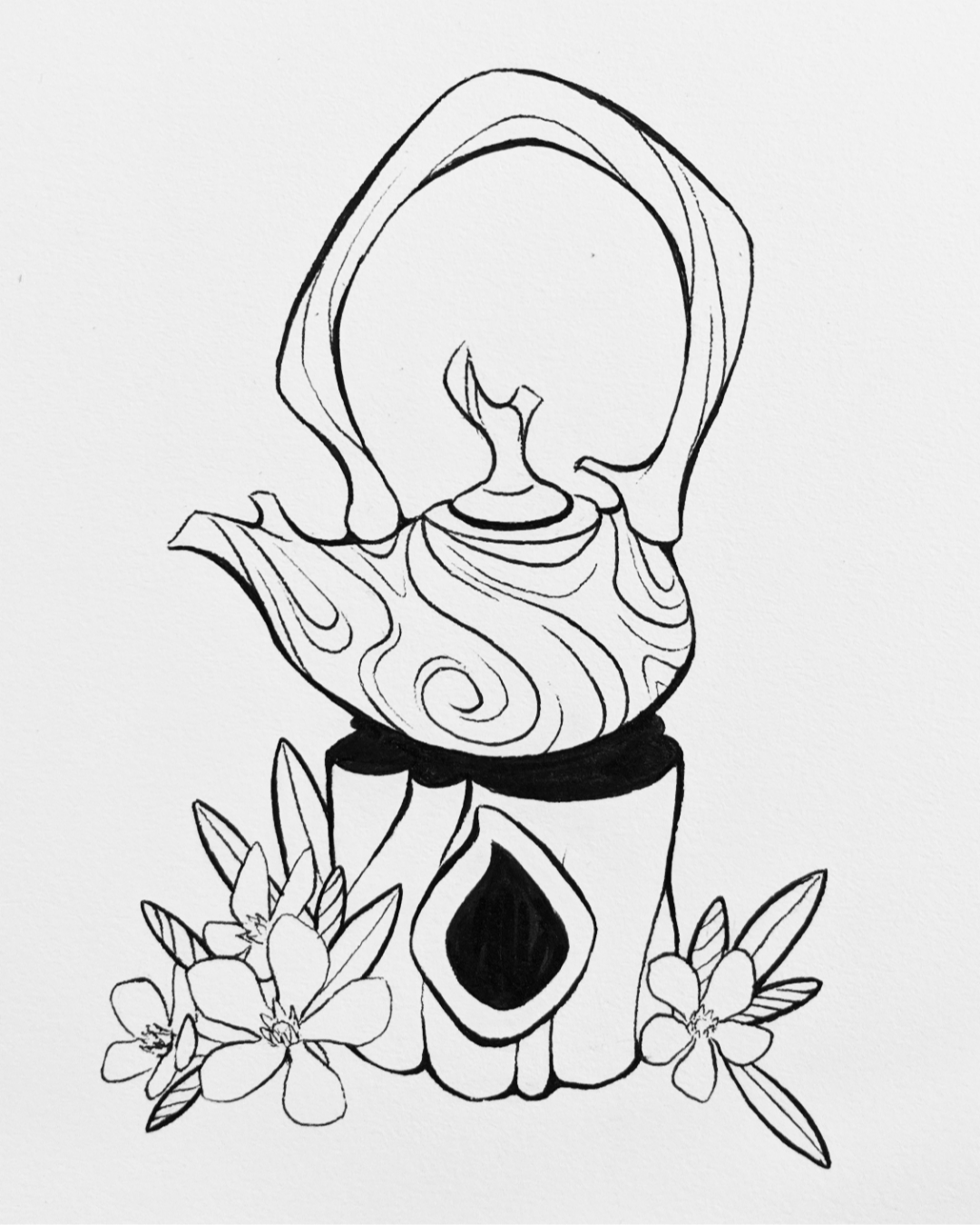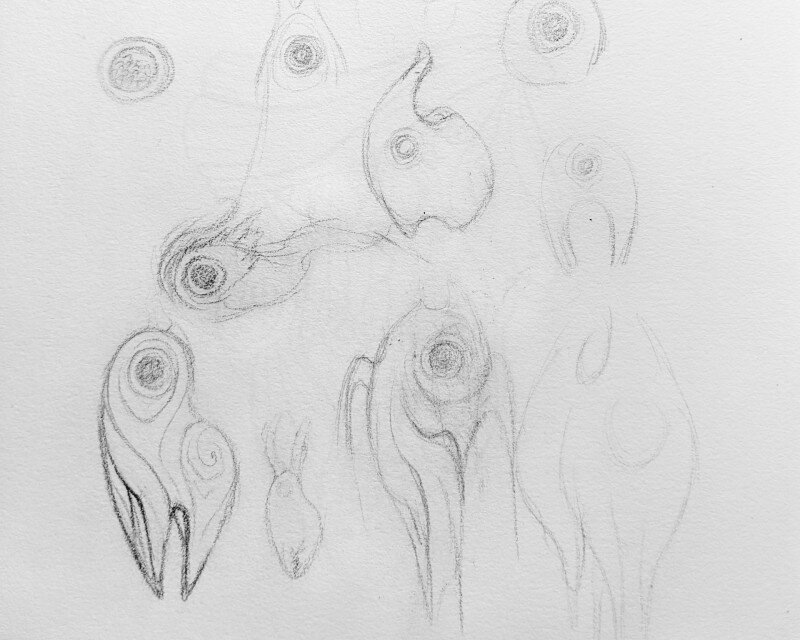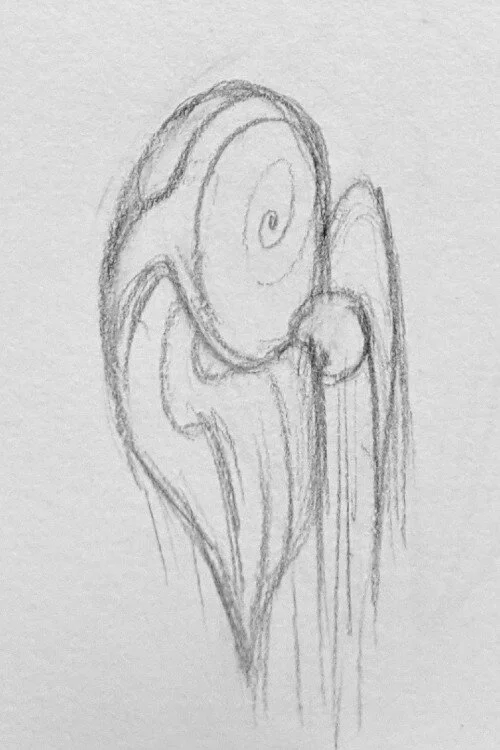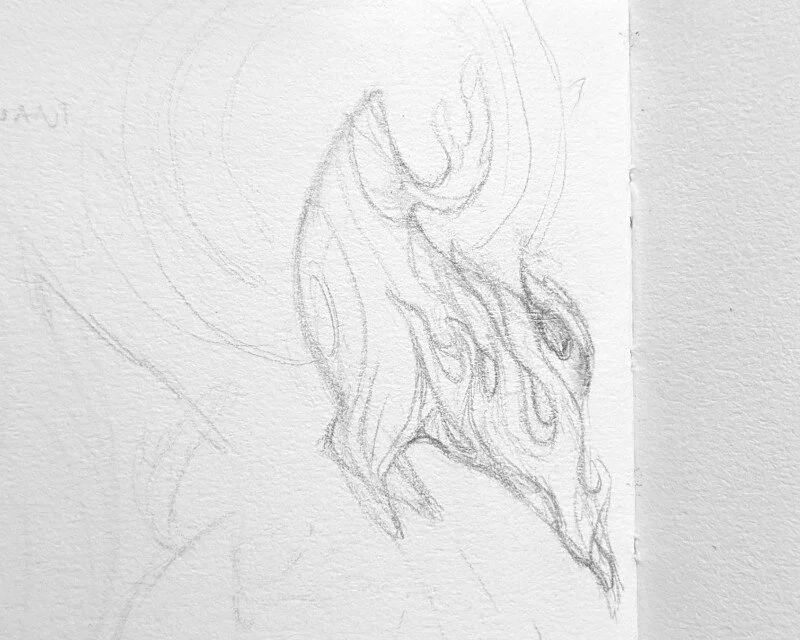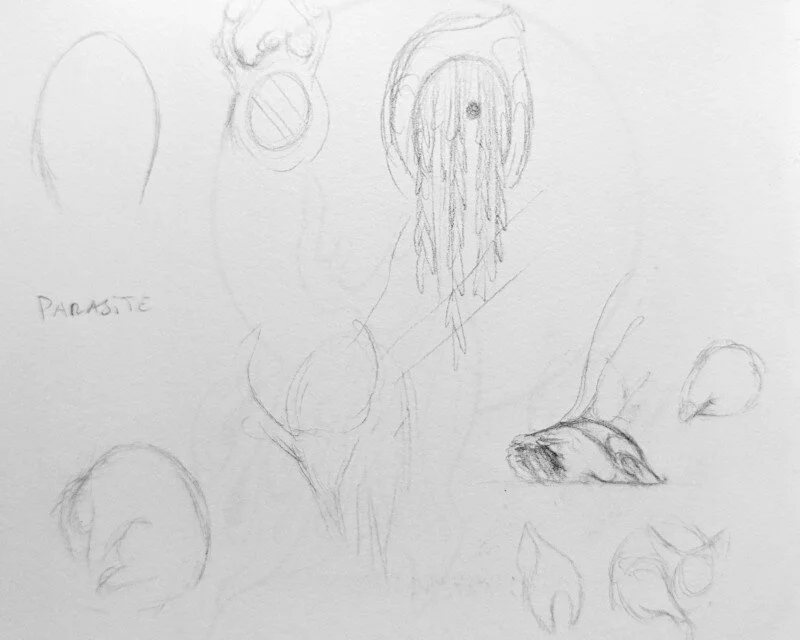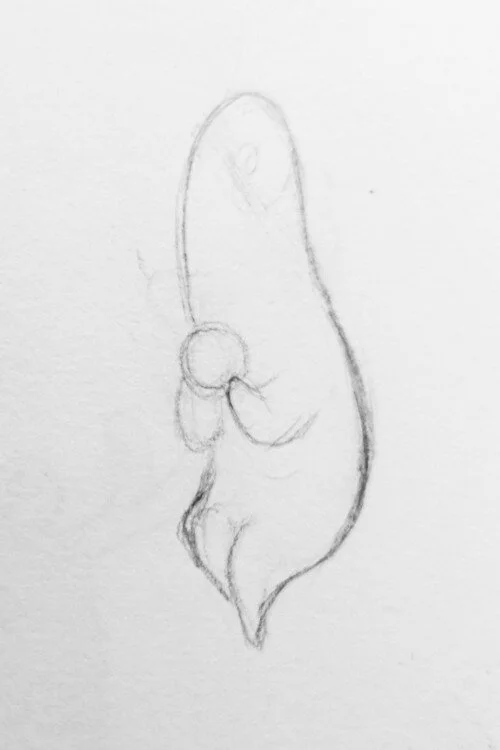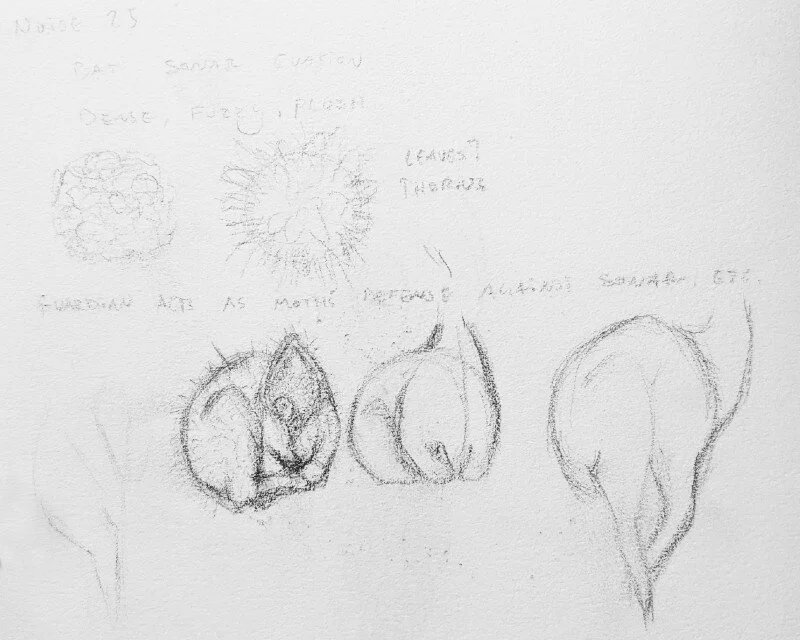Inktober 2019
Overview
This post details my experience with Inktober 2019 by providing deeper insight into my overall goals, sketch ideas, concepts, and materials. Inktober 2019 has long since passed, but I did finish late and thought writing about my process would still be beneficial to those interested. Click here to learn more about Inktober — it is essentially a drawing for each day throughout October.
I decided to draw up potential project ideas based on the Mossery Inktober prompt list. For some context — I was in the process of revamping my portfolio in order to apply to graduate school, so everything ties into the Moth Reliquary series. In addition to the sculptures I was already working on, I wanted to use Inktober to my advantage for some solid idea-building. I chose the Mossery prompts because they seemed more suitable for my body of work than the official Inktober list.
Process
I started by writing the prompts throughout the pages of my sketchbook. Each “day” spans two pages: the left page is for thumbnail sketches and notes while the right is for the final drawing. I jotted down some thoughts for each prompt, so that I would have a general idea of what to draw when the day came. Some days were more design oriented (thinking about form and aesthetics) while others were more concept based (rooted in research or fulfilling a specific purpose).
On average, I think I spent about four to five hours completing the entire process for a day. It’s really too much time in my opinion. In the future I’d like to work out a balance where my drawings are thoughtful, but don’t take too much energy away from my sculptures.
Each day started with either pencil sketches or research. Once I had an idea mostly resolved, I would sketch the final drawing on the right page and then line it with a brush pen. Lastly, I’d erase the pencil sketch and correct mistakes with a white gel pen. Some days I would add shading with a Prismacolor marker, embellish with gold watercolor, or add holographic pigment.
Materials
Speedball hand•book Travel Series Journal, Ivory Black, 5.5“x5.5”, 128 pages, acid free
Pencil
Sakura Pigma Brush Pens (fine tip)
Sakura Gelly Roll, White
Prismacolor Premier marker, Warm Grey %10
Daniel Smith Luminescent Watercolors, Iridescent Gold
Culture Hustle Stick x Prysm
Oleander Teapot
Day 1: Brew
The prompt “brew” naturally conjured the thought of brewing tea — hence the teapot drawing. Personally, I am not an avid tea drinker, but I find tea culture to be very fascinating; it has a rich history and many different practices.
Daphnis nerii the Oleander Hawk Moth has a dependent relationship with the Oleander plant: the caterpillars eat the poisonous oleander to absorb the toxins as a defense against predators. Can you brew a ‘tea’ using oleander leaves and flowers? Ultimately, I imagined it would be nice to have a tea time and serve tea to the moths and caterpillars.
Loose concept sketches. The stump is supposed to be a burner stand.
Tea Ceremony
Day 2: Steep
Oleander Teapot plays a role in Tea Ceremony: a tea is made with the leaves and flowers of the oleander plant, which is then used to nourish the small guardian. This guardian holds an urn at its heart and sits within a shallow basin. The tea must be poured over the guardian and then in the basin, so that it can soak and grow. This guardian is specifically for the Oleander hawk moth.
I drew inspiration from the traditional practices surrounding Yixing teapots. Click here for a video to learn a little bit more about Yixing teapots and brewing.
Wreath Dish
Day 3: Dinner
I see this piece as a porcelain dish surrounded by porcelain foliage and small urns. A dish seemed appropriate for the idea of serving food — leaves for hungry caterpillars and flower nectar for thirsty moths. Spirals are a common motif in my designs, to me, it can symbolize a journey, confusion, or create a focal point. I think it’s quite fitting for moths.
Lure Guardian
Day 4: Watch
This guardian attracts moths with dangling lights and guides them to safety. The background scribble is based on a page in my sketchbook where I traced a moth’s flight path in real time as it whirled through the air. I’d like to trace more paths and make them into a series of prints or a small book someday.
Some notes with my thought sequence. Preliminary sketches for Day 23.
Full Moon
Day 5: Round
The moon plays an important role in the theory that moth’s use celestial navigation. I imagine that through all the foliage of a forest, a moth could follow the moon an find its way out or keep track through all the twists and turns. In this sculpture, the urn is round like a full moon to symbolize that the moth spirit will always find its way.
Usually, I sculpt leaves and flowers with porcelain to visually connect them to the urn, but in this case, I wanted the urn to be the brightest like how the moon would be at night. I wonder how black leaves and flowers would look in contrast with a white urn.
Operculum
Day 6: Door
As a child I would find these sort of round buttons on the beach. One side was domed and the other flat with an ingrained spiral. Later, I learned that they are the opercula of gastropods — basically a kind of door for a snails’ shell. A round, spiraled door seems fitting for the entrance to the spirit world.
The theme for this sculpture is transcendence. A lotus patch grows atop a water world with a door at its center. Like the lotus flowers which rise from the mud and bloom above the water, the moths undergo their own transformation and will leave this world to enter into the spirit world. Only lost spirits may enter through the operculum in to a place of rest.
The Steward
Day 7: Climb
White Honeysuckle offers attractive flowers and shrubbery for moths to hide in. It lives symbiotically with The Steward and parallels the moth’s journey through life. The honeysuckle grows upwards to the moon-like urn, it flowers and then eventually dies. This steward is a nature being in the spirit world with anthropomorphic and zoomorphic qualities.
I tend to sketch beings facing to the left, so I reversed the sketch to help curve that habit. I like that you can see the vine growing up its back and over the cladus.
Armor
Day 8: Quiver
Moths will flash the bright colors or eyes on their hind wings to scare predators. Their wings are covered in tiny scales that people often mistake as dust. These seemingly fragile structures are one of the moth’s main defenses.
There are two inspirations for this drawing: the millions of butterflies that migrate to to Mexico, creating dense patches of wings everywhere you can see and Vanity by my favorite artist, James Jean. Both instances involve butterflies, so I wanted to create a moth version.
Defender
Day 9: Eye
Defender has a singular eyespot to frighten away predators of moths. It does not see with the eyespot — all the guardians I create do not have typical facial features, but rather, it can sense presence. When on the defense, this defender will face predators and charge them. If intimidation does not work, it will use its cladi as a last resort.
A possible reason why moths and other creatures form eyespots is to mimic the eyes of a different animal in order to deceive predators. I like the idea that this guardian does the reverse — it’s mimicking the eyespots of moths to to form a fearful relationship for that specific pattern. I’d like to make different defenders with different eye patterns.
Thanatos
Day 10: Deliver
Thanatos is the god of nonviolent deaths in Greek mythology. This guardian delivers a peaceful passing to the moths.
I find Greek mythology to be really intriguing and mysterious. At first, I was thinking of Charon, the ferryman who carries souls across the river Styx, but it didn’t really fit in with how I portray the spirit world. On the other hand, Thanatos resonated much more with me, because the death he brought was regarded as gentle — I have a lot of empathy for moths and hate to see them suffer.
Fleeting Life
Day 11: Quick
Burning out in the chase that is ‘life’. The flames destroy the physical body while releasing the soul.
The Host
Day 12: Stranger
Thinking about the feeling of uneasiness about ones self. It’s as if deep down you know something is wrong — unwittingly planting a seed of self doubt.
There are various parasites that affect moths, including the cordyceps fungus which inspired this drawing. Spores infect the host, taking control of its nervous system and effectively killing it, and then the fungus fruits to disperse more spores.
Wounds
Day 13: Graze
A reminder of mortality and how fragile life can be. This guardian perseveres with the will to continue on.
The Thicket
Day 14: Moonless
The glow from within this guardian draws moths in on moonless nights. It’s intertwining structure keeps intruders at bay.
Shrouded Guardian
Day 15: Fiction
There are only two species of moths in the United States that eat clothes and they only eat fibers that originated from animals, such as wool and silk. Not many compared to the nearly 11,000 species of moth in the U.S. Are you sure moths are the ones making holes in your garments?
This guardian is shrouded in leaves as if it were wearing them. It will provide plenty of foliage for caterpillars in the spirit world.
Blossom Guardian
Day 16: Hold
This guardian lulls the souls to rest within the comfort of sweet blossoms and a protective grasp.
Alula Guardian
Day 17: Distant
Alula or ‘Ōlulu is a flowering plant endemic to Hawai‘i, and native to Kaua‘i and Ni‘ihau. Invasive species and weeds have driven Alula to near extinction in the wild with only one known plant left growing on a cliff-side. Its main pollinator, the Fabulous Green Sphinx Moth is so rare (and once thought to be extinct) that conservationists must scale the cliff to hand pollinate the flowers.
The Alula Guardian represents this struggle of survival. Its flowers await and a cavity remains empty until a moth returns.
Portal
Day 18: Future
This frame represents moving towards the future in regards to environmental conservation. The outside is the present- lifeless. The future within is spilling out flowers, like a last cry for help from this world.
I may revisit this idea. Started falling asleep while outlining.
Hidden
Day 19: Hidden
Some moth species pupate just below the soil. This reliquary symbolizes protection and abundance from the ground where trees, flowers, and even moths can belong.
Lingering
Day 20: Linger
Some moths must rely on the energy they consumed as caterpillars to survive in their adult cycle because they don’t have the ability to feed. They search for mates and then perish in about a week.
The surviving flowers represent the last bit of life in the moths before they fade away.
New Beginnings
Day 21: Room
An old life leaves the foundation for a strong new one. There is room to flourish, and the legacy continues.
This drawing is more symbolic in nature rather an a guardian. It appears as a chopped tree with only a stump remaining, but has four ‘feet’ as if it were a mobile creature. The horizontal cut suggests the ‘death’ and reveals tree rings which are actually a spiral. A new sprout emerges of the center rather than from the edges like an actual tree. It feels familiar, but is actually strange. It is a resilient force of mystery of and magic.
Flutter Lamps
Day 22: Flutter
I imagine these as glowing orbs gently illuminating a room. Each orb would display a unique moth flight pattern. It would be amazing if the patterns could cast shadows across the space.
Sacrifice
Day 23: Pierce
The concept for this guardian is protection through sacrifice. The pose is based on a frolicking sheep, but rather than fleeing from danger, it faces the threat in order to protect the urn. The wound becomes integrated with its being; I imagine the figure to be forever frozen in this state. The arrow represents the threat brought on by people while the guardian represents an act of selflessness. The collision of both leaves neutrality where the moth is free to exist for itself.
Rainfall
Day 24: Glisten
This guardian provides shelter from a downpour. The urn is protected from dangerous droplets and it can rest peacefully until skies clear.
Thinking about resin for droplet effects.
Thistle
Day 25: Noise
Thinking about defenses and means of protection. The fuzziness of moths can aid in diffusing echolocation from bats.
This guardian has a fuzzy/prickly appearance that helps to disguise it’s shape from predators. Perhaps the bristles should be a bit more sparse.
Nectar
Day 26: Trickle
Some moths feed on the nectar from flowers and are also pollinators essential for specific plants. This drawing presents the symbiotic relationship where the moths and flowers thrive with each other’s presence. Nectar trickles in abundance within this health environment.
Celestial Eye
Day 27: Rhythm
Moth’s wings and bodies are covered in an innumerable amount of scales which is often mistaken for a kind of dust. The different shapes and colors of scales create the patterning. This design uses repetition of scales and circles to create rhythm. It references the eyespots on moth wings, but also celestial bodies, such as the sun and moon.
Yubaba
Day 28: Motion
Yubaba protects moth spirits from flying predators, such as bats and birds. The name is inspired by the character, Yubaba from Spirited Away, who can use magic to transform into a bird-like entity in order to fly.
Sphinx
Day 29: Guard
Based on the mythical creature, Sphinx, this guardian features various zoomorphic qualities for intimidation and offense.
Sphinx moth caterpillars (also called hornworms) pose in an upright position with their faces tilted down, which has been compared the the Great Sphinx of Giza which they are named after.
Eclosion Veil
Day 30: Hour
‘Eclosion’ in biology is the act of emerging from a pupal case or hatching from an egg. Fusing such action with the the time related theme, this guardian protects the urn with its veil of leaves until the spirit is ready to emerge.
Abundance
Day 31: Fortune
I interpreted ‘fortune’ as abundance and variety. Presented is a vessel with all kinds of flora, much like a cornucopia. It suggests not only the act of harvesting, but also of honoring by means of arrangement and offering.
Concluding Thoughts
Participating in this drawing challenge was very rewarding. I recreated some of these designs in clay sculptures and even repurposed some into new designs. I often look back on the drawings for new inspiration or just to consider their concepts in a new light. I’d love to try this again now that my work is changing and growing.



